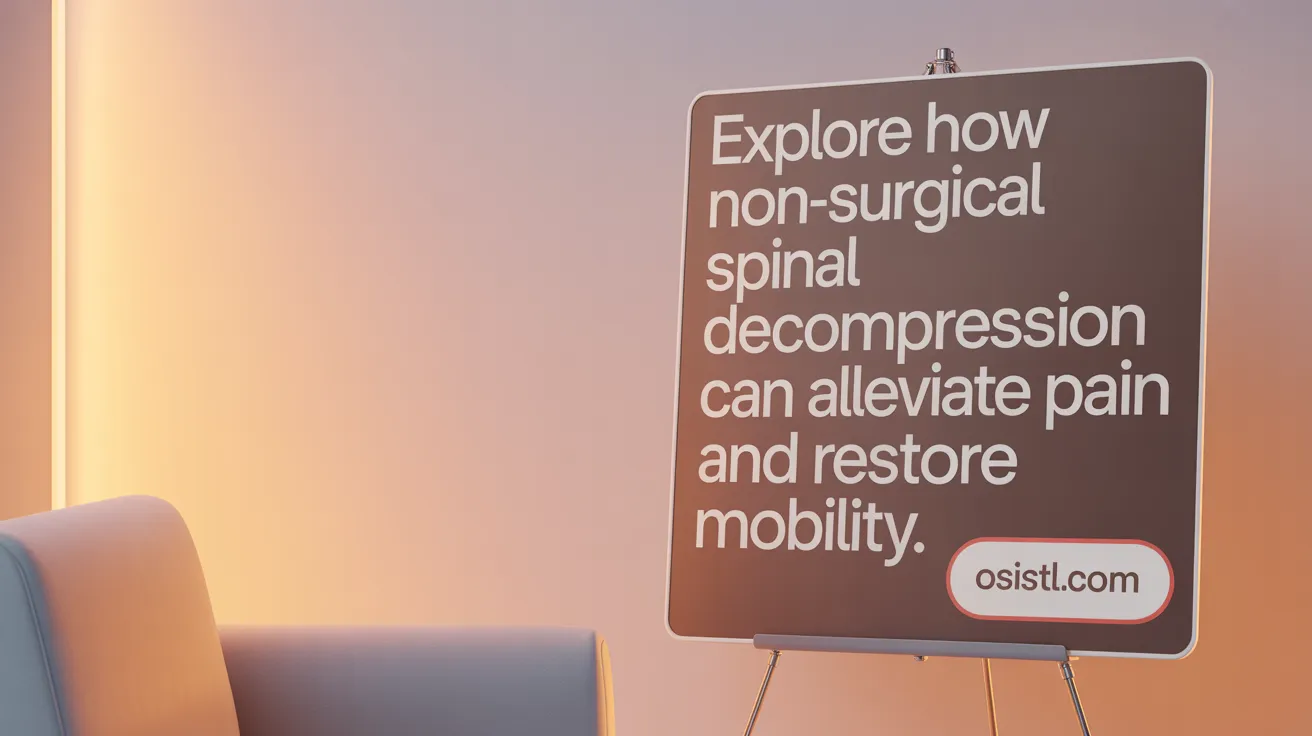The Shift Toward Non-Invasive Spine Care
As spinal conditions become increasingly prevalent due to aging and lifestyle factors, more patients and healthcare providers are turning towards non-surgical spine treatments. These therapies focus on relieving pain, improving mobility, and promoting natural healing without the risks and extended recovery time of surgery. This article explores the range of non-invasive treatment options gaining popularity, their benefits, and how they are transforming spine care.
Understanding Non-Surgical Spine Treatments and Their Benefits

What are non-surgical spine treatments and which conditions do they address?
Non-surgical spine treatments involve a range of conservative, non-invasive therapies designed to manage spine-related issues without surgery. They focus on relieving pain, promoting healing, and improving mobility. These methods treat conditions such as herniated or bulging discs, degenerative disc disease, spinal stenosis, sciatica, chronic back pain, and nerve compression syndromes. Techniques include physical therapy for back pain, chiropractic adjustments, injection-based therapies, Non-surgical spinal decompression treatment, and lifestyle modifications.
What are the benefits of choosing non-surgical spine care compared to surgery?
Non-surgical spine care offers significant advantages over surgery. Most importantly, it avoids the risks associated with anesthesia, incisions, infections, and long recovery times. Patients benefit from faster recovery and less downtime, enabling a quicker return to daily activities. It is more cost-effective by reducing surgical fees and hospital stays. Additionally, non-surgical treatments adopt a holistic and multidisciplinary approach, addressing root causes through combined therapies such as physical therapy, pain management, and complementary treatments like acupuncture for back pain. This can yield sustainable improvements and enhanced quality of life.
How does a holistic and multidisciplinary approach help in non-surgical spine care?
Non-surgical spine care is typically delivered by a team that may include physical therapists, chiropractors, pain specialists, and rehabilitation doctors. This approach ensures personalized treatment plans tailored to individual conditions. By integrating exercise, manual therapy, medications, lifestyle changes, and alternative therapies, patients achieve comprehensive relief and long-term spinal health. Supporting natural healing processes and improving posture and strength help prevent recurrence and promote overall well-being. Learn more about the multidisciplinary spine care team and approach to holistic spine health management.
Non-Surgical Spinal Decompression: A Leading Conservative Therapy

How does non-surgical spinal decompression work, and what conditions can it treat?
Non-surgical spinal decompression utilizes a motorized traction table that gently stretches the spine in a controlled manner. This stretching creates negative pressure within the spinal discs, which helps retract herniated or bulging disc material back toward the center of the disc. This decompression reduces pressure on spinal nerves, alleviating pain and inflammation.
This therapy is commonly used to treat a variety of spinal conditions such as herniated and bulging discs, degenerative disc disease, sciatica, spinal stenosis, and posterior facet syndrome. By improving spinal alignment and enhancing blood flow, decompression supports the natural healing process and helps restore mobility.
What does the treatment involve and how effective is it?
Treatment sessions typically last between 20 and 45 minutes and are administered over several weeks, often totaling 20 to 28 sessions. The procedure is non-invasive and pain-free, performed without anesthesia or incisions, which minimizes risks like infections or complications common to surgical treatments.
Patients frequently report significant pain relief, improved flexibility, and enhanced quality of life following decompression therapy. Studies indicate a high success rate, especially when combined with physical therapy and complementary modalities such as massage or acupuncture. However, while many case series and retrospective analyses show promising outcomes, further rigorous research is needed to fully validate long-term effectiveness.
The safety profile is excellent, with few reported side effects. This makes non-surgical spinal decompression a favorable alternative for patients seeking conservative care to avoid surgery, reduce recovery time, and achieve sustainable pain relief and spinal health improvement.
Complementary Non-Surgical Therapies for Spine Pain

What other non-surgical treatments are commonly used for back and neck pain?
Non-surgical care for spine pain typically involves a combination of therapies that address both physical and psychological aspects of pain.
Physical Therapy and Exercise
Physical therapy forms the cornerstone of non-surgical spine care, focusing on exercises tailored to individual needs. Core strengthening, stretching, posture retraining, and aerobic conditioning help improve mobility and reduce pain. Personalized exercise programs support spinal stability and prevent further injury.
Injection-Based Pain Management
To target pain more directly, injection therapies are often employed. Epidural steroid injections reduce inflammation around nerve roots, while facet joint injections and nerve blocks provide localized relief for specific pain sources. These treatments are usually part of a comprehensive management plan.
Mindfulness and Psychological Strategies
Chronic spine pain has psychological dimensions, and mindfulness-based techniques such as meditation, yoga, and cognitive behavioral therapy (CBT) play an important role. They help patients manage stress and the emotional burden of chronic pain, enhancing overall treatment outcomes.
Alternative Therapies
Complementary treatments like acupuncture and massage therapy stimulate the nervous system and promote relaxation, often reducing muscle tension and pain. Electrical nerve stimulation and laser therapy are also utilized to block pain signals and accelerate healing.
Integrating these therapies with medical and physical interventions creates a multidisciplinary approach that improves pain relief, functional recovery, and patient well-being.
Lifestyle Modifications and Preventive Strategies in Spine Care

How do lifestyle modifications support non-surgical spine treatment and prevention?
Lifestyle modifications are integral to both managing and preventing spine issues without surgery. Maintaining proper posture reduces unnecessary spinal strain, promoting alignment and comfort during daily activities. Regular low-impact exercises, such as walking, swimming, or yoga, help strengthen core muscles and improve flexibility, which stabilizes the spine and reduces pain flare-ups, as part of physical therapy for spine health.
Diet also influences spine health through its impact on inflammation. Eating an anti-inflammatory diet rich in whole grains, fruits, vegetables, fish, and nuts supports healing and can reduce chronic pain. Moreover, avoiding processed foods, trans fats, and refined sugars helps minimize inflammation that can exacerbate spinal conditions.
Smoking cessation and weight management are crucial lifestyle factors. Smoking negatively affects blood flow and nutrient delivery to spinal tissues, hindering healing and accelerating degeneration. Maintaining a healthy weight reduces mechanical stress on the spine, decreases the risk of degenerative disc disease, and supports better overall mobility.
Together with ergonomic improvements—such as proper workstation setup and supportive seating—these lifestyle changes complement non-surgical spine treatments by addressing root causes and supporting long-term spinal health and function.
Emerging Advances and Multidisciplinary Care in Non-Surgical Spine Treatment
What are some recent advances and comprehensive approaches in non-surgical spine care?
Non-surgical spine treatment has evolved significantly, incorporating innovative regenerative medicine options such as platelet-rich plasma (PRP) therapy and stem cell therapies. These treatments harness the body's natural healing abilities to promote tissue regeneration and repair damaged spinal structures, offering alternatives to traditional therapies.
Technological enhancements have also refined therapeutic precision and effectiveness. Instrument-assisted chiropractic adjustments allow for safer and more accurate spinal manipulation, while laser therapy stimulates cellular activity to reduce inflammation and relieve pain. Neuromodulation techniques use electrical impulses to target specific nerves, providing pain relief for chronic conditions without surgery.
A multidisciplinary team approach is central to contemporary spine care. Specialists including physiatrists, physical therapists, pain management experts, chiropractors, and psychologists collaborate to create personalized treatment plans. This teamwork ensures comprehensive care addressing not only physical symptoms but also psychological factors influencing pain. Examples of such approaches can be found in programs like the Spine Center at NYU Langone and Virginia Mason Franciscan Health Spine Program.
Looking ahead, future directions in non-surgical spine care focus on integrating personalized medicine strategies. This may involve tailored combinations of medications, advanced physical therapies, and cognitive-behavioral interventions to maximize treatment outcomes and improve patients' quality of life, as highlighted in comprehensive guides on multidisciplinary spine care and holistic spine health management.
The Future Is Non-Surgical: Advancing Spine Care with Innovation and Compassion
Non-surgical spine treatments are gaining momentum as effective, patient-centered alternatives to surgery. They offer safer, cost-effective options that emphasize healing, mobility, and quality of life. With ongoing research, technological advances, and a holistic, multidisciplinary approach, non-invasive therapies are poised to become the standard in managing spinal conditions. Patients and providers alike benefit from these evolving treatments that address pain comprehensively while minimizing risk, recovery time, and reliance on surgery.
